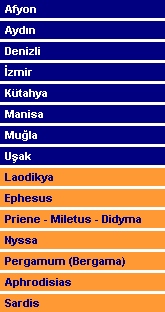| Priene - Miletus - Didyma... |
|
Priene which is in Güllübahçe at a distance of 15 km from Söke, was carried to its present locality in the year 350 BC
from the original place where it had been founded earlier. At the point of entrance of the ruins, a road on the right
leads us to the Theater of Priene. The theater had been built during the Hellenistic period, and underwent modifications
during the Roman period. The theater consists of 50 rows of seats and is capable of holding 5000 people and, in the section
of the orchestra of the theater, there are marble armchairs reserved for eminent people. On the right side of the theater,
the Themenos of Egyptian Gods is situated. The upper Gymnasium is in front of the theater and the Byzantine church is at
its side. You pass to the famous Temple of Athena from here. The Temple of Athena belongs to the 4th century
BC and it is the work of the architect Pytheos. The temple, with 6 x 11 columns, has dimensions of 19.55 x 37.20 m. A few
columns of the temple, which is a classical example of Ionian architecture, have been erected. Alexander the Great had the
eastern half of the temple completed. The altar in the front was decorated with high reliefs in the past, and it belongs
to the 2nd century BC. The Stoa that displays a graceful example of stone-workmanship, is on the south of the
Temple of Athena. When you go downwards from the temple, you see the Agora of Priene which belongs to the 3rd
century BC. The sacred Stoa belonging to the 2nd century BC, is situated north of the Agora. Bauleuterion (the
assembly building) which looks like a small theater, with dimensions of 20 x 21 m and capacity for 640 people, is adjacent
to the Stoa and, adjacent to it, there is Prytaneion (2nd century BC) where the sacred fire used to burn.
Temenos of Zeus Olympios and the food market are situated east and west of the Agora respectively. There are houses on
two sides of the avenue which connects the Agora to the western gate. Temenos of Kybele and the house of Alexander the
Great, are situated at the western gate side of the avenue. In the extreme south of Priene, the lower Gymnasium and the
Stadium are situated. Miletos which is in the vicinity of Söke, was on the seashore in the ancient times. The Miletos
people who had founded about 90 colonies in the Mediterranean and Black Sea regions, after 650 BC, had resisted the
Persian invasions in Anatolia, but they were defeated finally and the city was destroyed by the Persians.
|
|

|









